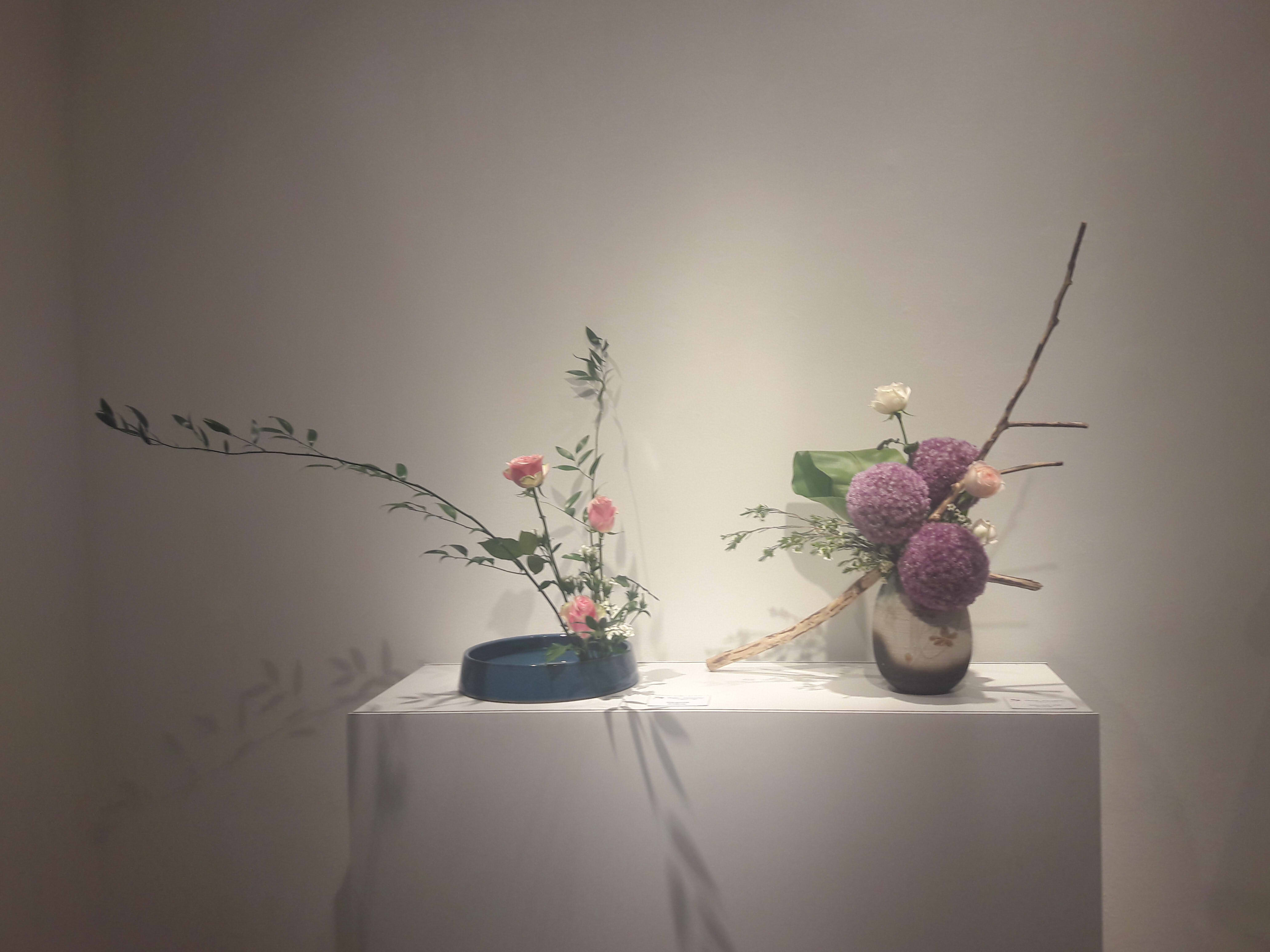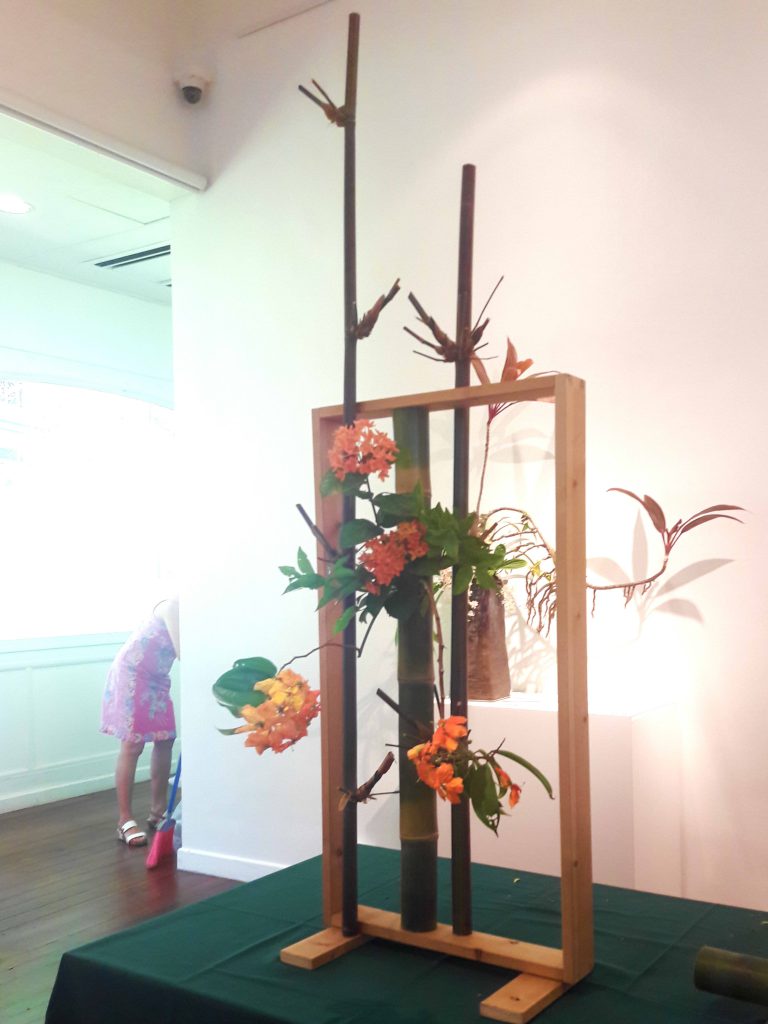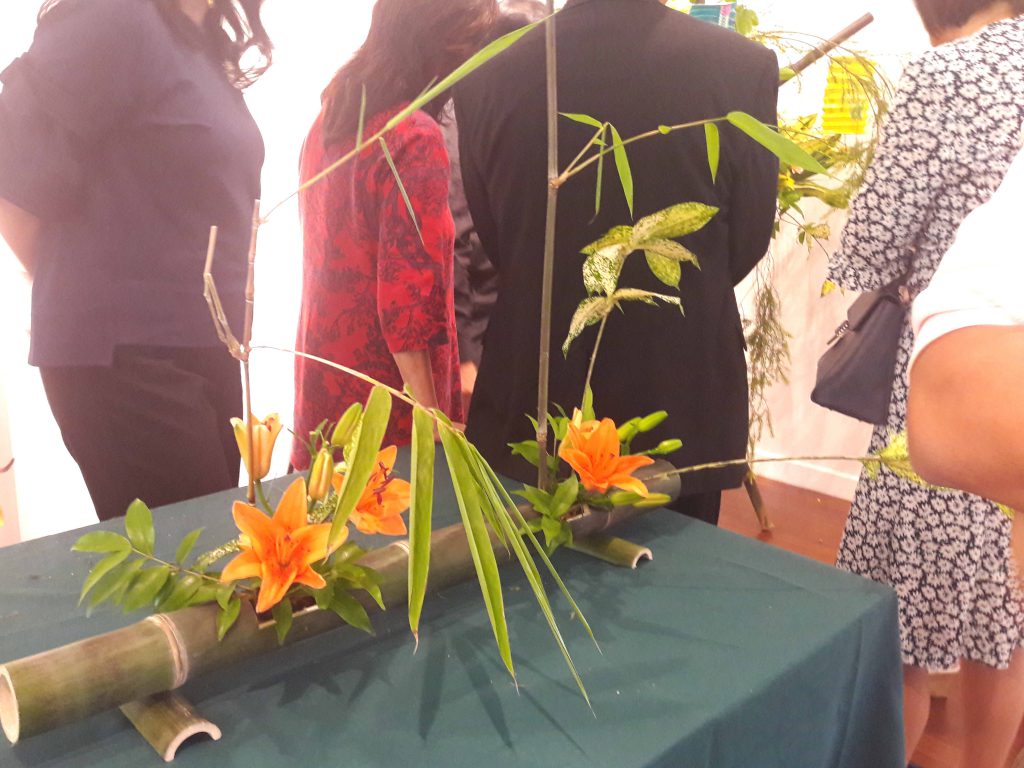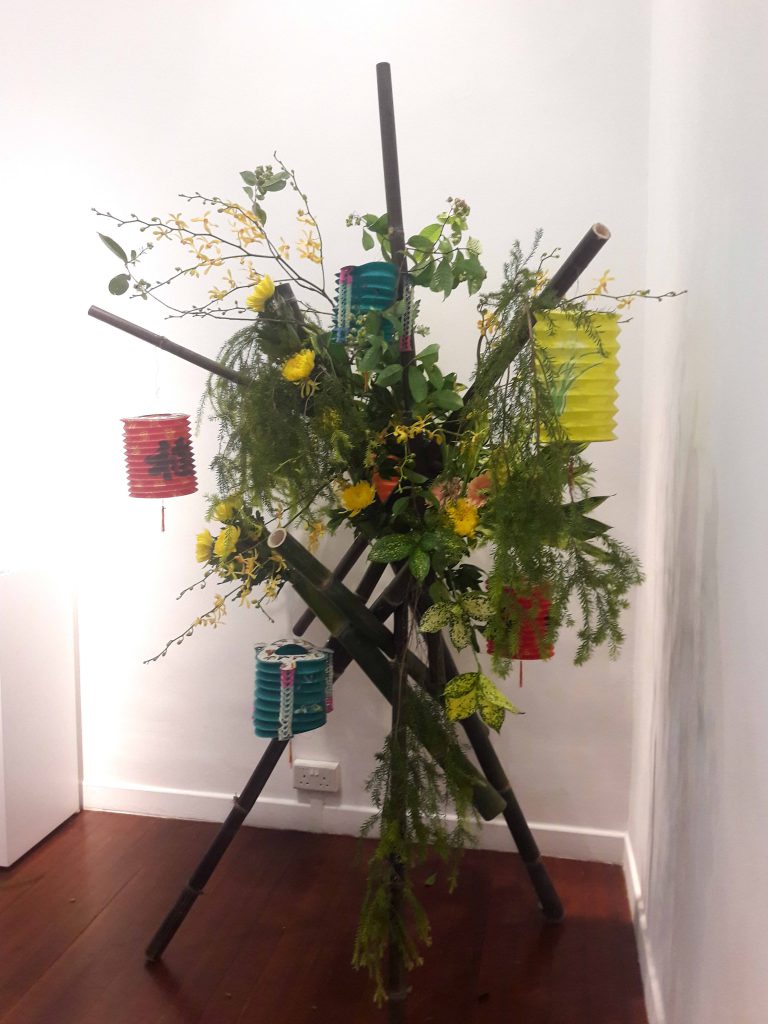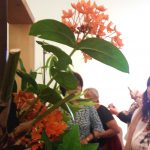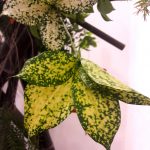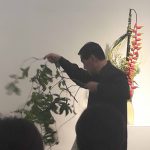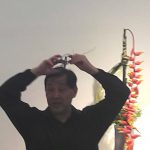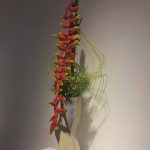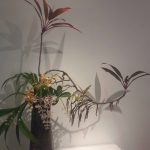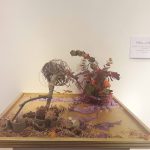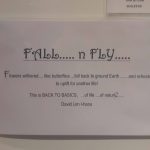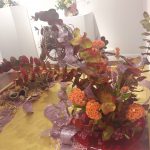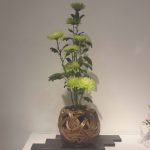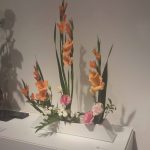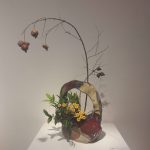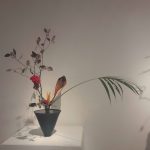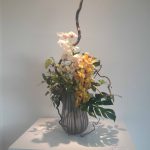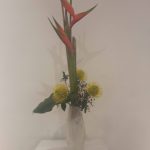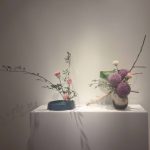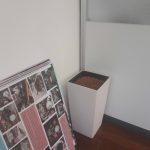I have never written an article before, so this ought to be good.
On October 2 (Monday), I attended the opening of the Ikebana, back to basics exhibition by the Ikebana International Singapore Chapter 135, hosted at the Japan Creative Centre.¹

The atmosphere is somewhat unnerving, from the average age being twice of mine, to the fact that a doorman opens the door and greets you personally.² Part of it is also perhaps just the minimalistic elegance of the rooms, which are small and uncluttered. An ikebana and introductory placard can be seen before the doorless chamber, no bigger than a typical classroom.

Bathed in gentle, warm lighting, the white walls were lined with various flower arrangements at apt intervals. Upon closer inspection, placards could be seen beside each ikebana, inscribed with the name and school of the creator. An overwhelming majority were of Sogetsu, with a few from the other 5 schools being displayed.
The chamber was adorned by white chairs, barely enough to seat 20 people, with an aisle in the middle. I quickly settled in the barren back row. My awkwardness was masked by my act as an enraptured audience member (or, at least, I hoped it was). A long table adorned by a sea green cloth remained empty, though the corner was occupied by a bamboo structure which jutted out at various angles.
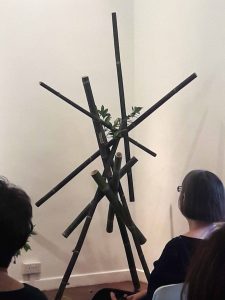
⁴ The event began with the opening speeches of two distinguished speakers: Mrs. Yuko Shinoda, the wife of the Japanese ambassador to Singapore, and Ms. Angela Kek, the President of the Chapter. They spoke of the progress of the Chapter since its founding in 1969, where educational platforms to bring ikebana to Singapore have flourished⁵. Furthermore, the Japanese art of ikebana still remains rooted in traditional forms, despite having adapted to modernity. This was the inspiration behind the theme of “basic”, in returning to basic rules and concepts.
Some other important figures were also introduced, such as Ms. Akiko Sugita, the Director of the Japan Creative Centre, and various members of what, presumably, is their exclusive inner circle.⁶
A live exhibition ensued, showcasing the working process of Mr. Peter Chin, a committee member of the Floral Designers Society (Singapore). A floral designer who has been in the business for 43 years, he created 3 ikebana within approximately 15 minutes each, colouring his working process with live commentary. All 3 ikebana used different bases, and thus, presented various techniques.
Throughout the demonstration, he gave numerous tips involving plant freshness, maintenance, and colour coordination. For example, that bamboo could be rejuvenated through soaking, and that rotting flowers could be saved by trimming. In light of autumn, he chose orange flowers, offset by yellows and pinks to evoke the earlier parts of the season.
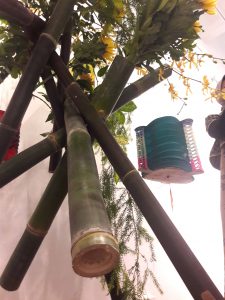
As an avid user, he also provided many details on bamboo. Different varieties of bamboo have different qualities, such as with the hardier black bamboo. In addition, bamboo can grow up to half a metre per day, as a versatile grass (yes, bamboo is a grass!). It also stores water easily, and is often so expansive that they cross each other at haphazard angles. He fondly recounted a tale of a guard attempting to accuse him of cutting bamboo in the forest. The punchline, of course, being that said guard could not tell where exactly the cutting had occurred.
Chin also commented extensively on the use of plants to suggest direction. “These are just basically finishing touches to give it more flow,” he explained, as he clipped branches with a resounding twang. “The main feature which is the flowers, then the rest flowing along the sides to give it more movement… to make the arrangement more lively,” he continued, framing the golden chrysanthemums with yet another wispy fern.
For the benefit of everyone, I have summarised the more inferential points mentioned in his soliloquies below:
- Local procurement
Noting that many people believe ikebana to require exotic, foreign materials, he specifically worked with local flora, such as ixora, and nameless branches he randomly found along the way. The explanation given was that local materials can still provide beautiful forms to work with.
2. Curating materials
Often, one may find a branch plenty beautiful in its natural state, or end up trimming it far too much. The key, he said, was to focus on what you want from it. If you wanted to focus on the curve of the branch, you could even strip its leaves entirely, as he demonstrated for us. “Don’t feel uncomfortable with plucking off or cutting off!” he exclaimed, as he ripped leaves off a branch. He then proceeded to curl it.
3. Natural joining
Save for certain situations, he attached the materials with no additional assistance from fixatives like glue or rope. Branches were placed vertically, by sectioning the stem into 4 at the bottom to form a solid base; stems were twisted, to counter turning momentum; flowers were slotted into cavities, where they fit snugly.
4. Plant coordination
Even plants which may not seem to work together may come together surprisingly. He recommended keeping a stock of plants which one might wish to use and experimenting accordingly, than making assumptions based on prior knowledge. He also recommended picking colours in relation to each other and the season, as with the black of the bamboo offset by green, and hints of yellow and pink.
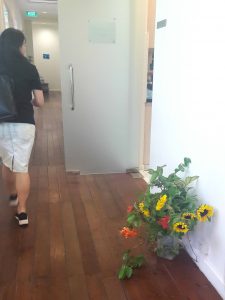
After his demonstration ended, there was a food reception and free tea from Premiers. The audience quickly dispersed to either grab the free food, or take photos of his completed works. I was the latter, before I decided that it made more sense to come back later once the crowd lost interest, heading over the tea section instead. A quick look at the menu revealed a nice variation of few teas, from classical Darjeeling to exotic Assam, quirky Chocolate to floral Chamomile.⁸ There was also a bizarre cold tea named Celebration, (which I never got to try due to limited stock, sadly), and the display was rather elegant.
It took a while to realise that the tea counter was to be visited AFTER the food, and thus I headed to the queue for food. Kueh of different colours were displayed, from the beloved rainbow to purples and greens, followed by typical catering trays filled with typical Chinese things like bee hoon and fishcakes. During this time, Ikebana A was also presented to Mrs. Shinoda.
Further exploration revealed that there was, in fact, another room displaying even more ikebanas from various people. Compiled are photos of almost all displayed ikebanas, both in that room and out of.
Even more wandering around revealed an eLibrary, though it was, unfortunately, off limits to the public. Also an office, but that’s not as interesting. With nothing much left to do, I absconded with about 7 different brochures and magazines (and sachets of tea).
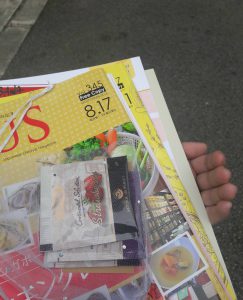
All in all, I’d say that I likely interpreted everything differently from the masses, who were more likely there to observe another’s techniques and adapt accordingly (I still have no idea what I was doing there, really). It was vaguely enlightening, nevertheless, to see the different techniques and forms which arose depending on the base and types of plants used. From stiff and tall to soft and wide, from those meant to be viewed only from the front to those which were 3-dimensional, complex coordination was done to bring out something as simple as prettiness.¹⁰
If my failure of an article has somehow spurred you to take a look, the exhibition is open to public and still ongoing until 5 October, from 10am to 6pm! You can find more details here. If it hasn’t, well, at least you kind of know what happened, right?
Personal comments which seemed inappropriate are here, labelled by numbers.
¹ I was mostly assuming there would be another NTU student there, but quickly came to the realisation that I had been abandoned by everyone else who had said they wanted to go. I was easily the youngest person there, even including J.W., so fair warning: you might feel awkward and out of place if you go alone.
² My relief knew no bounds when they avoided calling me “ma’am” like they did the others.
³ I would soon regret this, considering the average height of the people in the room versus mine.
⁴ Here, I will take the liberty of admitting that I did not listen particularly thoroughly so I’m not too sure on if they WERE the speakers and who said what.
⁵ haha geddit
⁶ I personally think the Chapter sounds like a secret society name.
⁷ It SOUNDED like vanilla, but I’m quite sure it wasn’t. So I have no idea. Maybe just water.
⁸ Personally, the bee hoon was subpar, but the fishcake(?) was superb. I will never reject free tea, but I was vaguely disappointed that there wasn’t Earl Grey, which is easily my favourite black tea. This was resolved by the gift bag they gave at the exit, though.
⁹ There were definitely some which were better than the others to me, though, but that’s likely just my personal taste. I particularly enjoyed those which involved wild careening to the left/right, than those which were more rigid with straight, vertical lines. Those which used artificial plants also fell into my general disregard, because of the waxy appearance and lack of natural blemishes which makes everything so much more interesting in my opinion.
